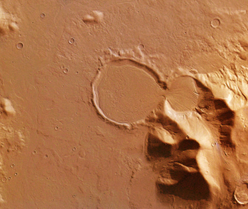Mars Express science highlights:
#3. Identification of recent glacial landforms
One type of evidence came from HRSC images that revealed flow-related features known as debris aprons, which slope gently away from mid-latitude scarps or highland massifs. Often hundreds of metres thick, these flows have lobate (curved) margins, and were interpreted to be viscous flow features composed of ice-rich material derived from the adjacent highlands.
One classic example was found in the eastern Hellas region of the southern hemisphere, where an 18-km-wide lobe extends about 8 km from the base of a 3.75 km high massif. The lobe is some 250 m thick, has a convex upward topographic profile, and is separated from the base of the massif by an irregular 50–100 m deep depression.
 |
|
'Hourglass' shaped craters filled with traces of glacier. Credit: ESA/DLR/FU Berlin (G. Neukum) |
Even more striking was imagery of an unusual hourglass-shaped structure located in Promethei Terra, at the eastern rim of the Hellas Basin, the largest impact structure on Mars. A so-called ‘block glacier’, an ice stream covered with a large amount of scree (small rocks of assorted sizes), had flowed from a flank of the massif into a bowl-shaped impact crater, which was filled nearly to the rim. The block glacier then flowed outward into a much larger, adjacent crater, taking advantage of the downward slope.
The relatively recent origin of these flow features was demonstrated by the absence of impact craters on the deposits. However, evidence of extensive sublimation (vaporisation of ice) and wasting strongly indicated that the current environment is no longer suitable for such large-scale glacial accumulation and flow.
The HRSC also revealed the presence of young glacial deposits in equatorial regions. Evidence for extensive, debris-covered glaciers along the north western scarp of the huge Olympus Mons volcano had been noted by previous space missions, together with the tropical mountain glaciers at the Tharsis Montes volcanoes. These huge glacier-like features formed more than one billion years ago.
HRSC data revealed the presence of several additional rock-glacier-like features along the basal scarp of Olympus Mons. These relatively small flow features, marked by curved, concentric ridges, were superposed on top of the larger glaciers, and clearly much more recent in origin.
These observations were of particular importance to scientists who try to piece together the climatic history of Mars. They indicate that glaciers formed until a few million years ago, when the planet was warmer and possibly also had a thicker atmosphere. The climate then seems to have changed, possibly as a result of a shift in the tilt of the planet’s polar axis, so that the glaciers became inactive or retreated due to the lack of continued supply of ice. Since then, they have been protected from sublimation by a thin coating of dust.
